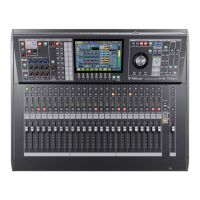108
Effects and GEQ
Effects and GEQ
1.
Access the GEQ EDIT popup for the desired GEQ.
fig.ScrGEQEdit.eps
2.
Use the EQ MODE select buttons to select 8-BAND PEQ.
fig.EQChg_Conf.eps
A message will ask you to confirm the operation.
3.
Press [F8 (CHENGE)] to switch to the 8-band parametric
EQ.
8-band parametric EQ
fig.ScrPEQEdit_Guide.eps
EQ graph
This indicates the approximate characteristics of the 8-band
parametric EQ.
Parametric EQ
Here you can adjust the filter for each band.
fig.ScrPEQ_Guide2.eps
ON button
This turns the filter on/off.
TYPE
This selects one of the following filter types:
Q
This adjusts the Q in a range of 0.36–16.00. Higher values
produce a sharper curve.
This is not shown when LSV, HPF1, HSV, or LPF1 is selected as
the filter type.
FREQ knob
This adjusts the frequency in a range of 20 Hz–20.0 kHz.
GAIN knob
This adjusts the gain in a range of -15.0 dB–+15.0 dB.
This is not shown when HPF1, HPF2, BPF, NOTCH, LPF1 or LPF2
is selected as the filter type.
The 8-band PEQ can be adjusted using the EQUALIZER area
controls. The corresponding bands will be highlighted on the
screen. The highlighted area moves with the cursor.
The function buttons have the following operations:
For the 8-band parametric EQ, you can switch the analyzer
between visible and hidden. Use [F6 (Analyzer)] to show or hide
the analyzer.
fig.ScrPEQEdit2.eps
If the analyzer is hidden, the EQ graph’s vertical axis will be
shown larger.
Using the 8-band parametric EQ
1
2
1
2
1
2
3
4
5
1
Type
Function Desc.
LSV
Low shelving 1 only
HPF1 -6 dB/oct high-pass filter
HPF2 -12 dB/oct high-pass filter
PEAK Peaking
BPF Band-pass filter
NOTCH Notch filter
HSV High shelving 8 only
LPF1 -6 dB/oct low-pass filter
LPF2 -12 dB/oct low-pass filter
[F4 (FLAT)] Sets the 8-band PEQ to a flat response.
[F5 (LIBRARY)] Access the GEQ LIBRARY popup (p. 109).
[F6 (Analyzer)] Displays/hides the analyzer.
[F8 (CLOSE)] Closes the popup.
2
3
4
5
M-480_e.book 108 ページ 2011年3月2日 水曜日 午前9時20分

